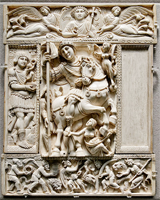
This page created 28 May 2014, and last modified: 28 September 2014 (misplaced tag fixed)

In the eastern half of the Empire, the Count of the Household Foot controls a single infantry bodyguard unit, called the Domestici Pedites. Its shield pattern as shown in various manuscripts is as below:

The pattern is extremely ornate. The boss is purple (yellow in B); (in O, P) it is surrounded by a narrow yellow band. This in turn is surrounded by a broad yellow band on which are inscribed 10 (O, M), 11 (P, W), or 16 (B) hearts (the hearts not defined in B, leading to a 16-pointed star). The main field is also purple and bears three charges in yellow: a circular imago (imperial portrait) at the 12 o'clock position, showing the face-on portrait of a single person's head; and flanking the imago, two winged Victories. The pattern is completed by a rim made of twinned narrow yellow bands; the inner band has inwardly-pointing projections, interrupted by where the Victories are positioned. It thus closely resembles the pattern of the Domestici Equites under the (eastern) Count of the Household Horse.
It is unclear to what extent, if any, the Domestici were military guard units at this (or indeed, any) date as opposed to being purely ceremonial; they seem to have functioned more as a staff officers college than anything else. In the 350s, Ammianus records Constantius being protected on the field by 'praetorian' foot guards who may well be the same as the Domestici pedites, but whether this guard survived into the 5th century as a military force is unclear. We also hear of protectores as bodyguards for commanders, but these do not find any place in the Notitia's organizational scheme.
Paired Victories flanking an imperial image are a characteristic late Roman motif, and can also be found on e.g. the Arch of Constantine (although in this case the imperial image has been lost; single Victories are also used on the same monument). The motif continued into the Byzantine era; the picture below of the early-6th century Barberini ivory in the Louvre shows how the Victories have been transformed into angels, and have been elevated to flanking a heavenly Christ rather than the earthly emperor.

Photo by Marie-Lan Nguyen and released into the public domain.
Interestingly, omitting the Victories and imago from this pattern gives a very similar shield pattern as shown in a mosaic in the 'legionary' bathouse at Alba just outside Rome, and from which the infantry component of the sacer comitatus may have originated via Legio II Parthica. This might indicate the unit concerned may have had a continuous history as a bodyguard unit stretching back to the end of the second century AD.

Return to the Notitia alphabetical unit list page.
Return to my Notitia index page.